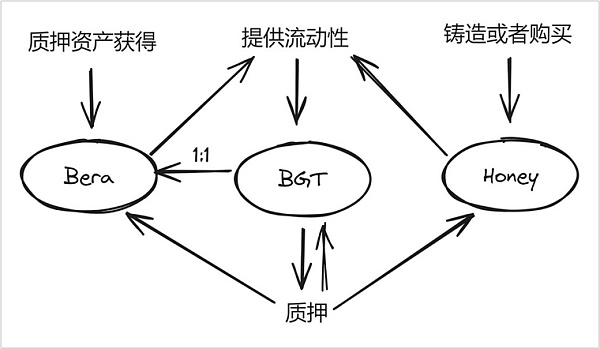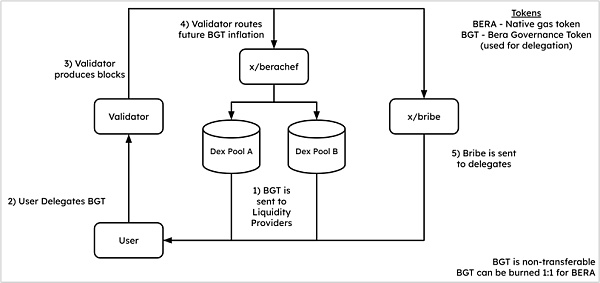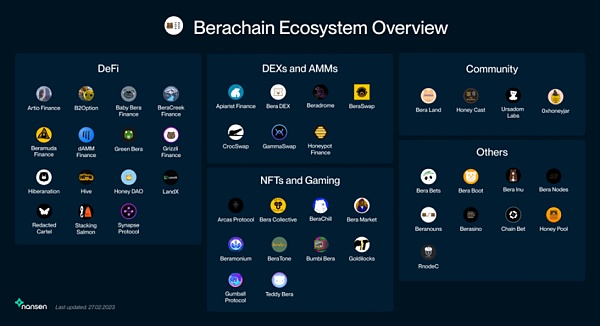In the rapidly developing world of blockchain technology, Berachain is making waves with its active community culture and innovative consensus mechanism. As a new generation of Layer
1 blockchain, Berachain aims to provide high security, decentralization and scalability while leveraging the power of meme culture and community to create a vibrant ecosystem.
Berachain attempts to solve the liquidity problem in the DeFi field with its unique three-token model and Proof of Liquidity Consensus (POL) mechanism. By dividing the currency into base currency, pledge currency and liquidity currency, the three-token model provides users with more participation and incentive mechanisms. At the same time, the POL consensus mechanism improves the security and performance of the network through the dual consideration of rights and time. On January 10, Berachain launched the test network Artio and plans to launch the main network in the second quarter of this year.
The Origin of Bera: FromBong Bearsto Berachain
Berachain is a public chain based on MEMME culture. Its original origin can be traced back to the non-fungible token (NFT) series Bong Bears. It was founded by four anonymous People (Smokey the Bera, Papa Bear, Homme Bera and Dev Bear) who claim to be cryptocurrency natives. The name Bera is deliberately misspelled as Bear in order to pay tribute to "HODL", one of the most famous words in the encryption circle.
The Bong Bears team was inspired by the rebasing protocol OlympusDAO, which saw its OHM token trade for as high as $1,300 in the fall of 2021. (The price has since fallen to around $10 per OHM.) Bong Bears follows in the footsteps of OlympusDAO, a protocol that quickly gained traction in the crypto community. The first rebased NFT collection was quickly created, which gave rise to multiple new collections – different types of bear image NFTs such as Bond Bears, Boo Bears, Baby Bears, Band Bears, and Bit. At present, the total value of the Bong Bears series NFT has reached 400E+.

Blockchain developments at any time. The Bong Bears team recognizes that while the traditional Proof of Stake (PoS) mechanism improves the security of the chain, it will lead to a reduction in on-chain liquidity, affecting operations such as transactions and liquidity providers (LP). In addition, the staking mechanism also suffers from centralization of staking and limited rewards. In order to solve these problems, Bong Bears members are determined to develop a new layer1 public chain to solve the long-standing DiFi liquidity dilemma.
Berachain co-created Smokey The Bera mentioned in the development history of Berachain previously shared that the core members of the Berachain team had deep feelings after experiencing bulls and bears in the currency circle. Liquidity is of great significance to DeFi. Compared with decentralization, scalability, security and interoperability, liquidity is the foundation of all this. The Bera team has absorbed the experience and advantages of successful projects such as Olympus DAO's POL (Protocol Owned Liquidity) concept and Terra's native stablecoin concept, and avoided their existing shortcomings.
In terms of consensus mechanism, Berachain adopts the most cutting-edge liquidity consensus proof mechanism, through liquidity providers, liquidity mining, liquidity proof and liquidity Mechanisms such as sexual governance realize network liquidity, centralization of rights and coordination between protocols and verifiers. In terms of the overall framework, Berachain has built a modular EVM framework using Cosmos SDK and Polaris EVM to provide an execution environment for smart contracts on Berachain. Any project can use Berachain to integrate and build new modular EVM. In terms of token model, Berachain has created an original three-token model, which separates gas Token and governance Token to solve the problem of liquidity loss caused by token pledge to a certain extent. In terms of culture, the Berachain community has a good atmosphere, has a MEME culture, and does not exclude Ponzi, which has greatly accelerated the construction and development of the Berachain ecosystem.
Berachain’s development has attracted widespread attention and support. It has achieved remarkable achievements in financing. On April 20, 2023, Berachain announced their 42.069M Series A financing. This round of financing was led by a number of well-known institutions and individuals, including Polychain Capital, OKX Ventures, Hack VC, Dao 5, Tribe
Capital、Shima Capital、Robot
Ventures, Goldentree Asset Management, etc. In addition to these institutions, 20 DeFi project founders participated in the investment, including former Dragonfly Capital partner and Celestia founder Mustafa Al-Bassam and Tendermint co-founder Zaki Manian.
PoL+ three-token model: Berachain technical features and advantages
Although Berachain originated from meme culture, it is not a technically weak MEME chain. This was fully verified when Berachain announced the launch of its public testnet Artio. In less than 10 days after Artio went online, it attracted more than 1 million testnet users and more than 70 ecological DApps. The biggest core advantage of Berachain compared to the traditional MEME chain lies in its unique token model and consensus mechanism.
Berachain’s token model
Berachain uses three tokens The mechanisms are BERA, BGT (governance token) and HONEY stable currency. Each token plays a specific role in the network and together builds the Berachain ecological economy.

BERA (Layer 1 native token):
BERA is the native token of the Berachain network and is used to pay transaction gas fees and block rewards.
BERA maintains the health and vitality of the network through the gas fee mechanism, and is also the basis for users to participate in network activities. One of the means of motivation.
BGT (Governance Token):
BGT is Berachain’s governance token and is non-transferable.
Users can provide liquidity on BEX, lend HONEY and provide it in Berps’ bHONEY vault HONEY and other ways to obtain BGT.
BGT holders can participate in governance decisions on the chain, such as the zoning of pledged assets. Block rewards and the selection of stakeable tokens are voted on.
Separating the governance token from the basic Gas token improves the fairness and fairness of governance Transparency, ensuring that the most active users do not lose governance rights by paying transaction fees.
HONEY (native consensus mortgage stablecoin):
HONEY is Berachain’s native consensus-collateralized stablecoin and aims to be close to the value of 1 USDC.
Users can mint HONEY by staking other assets on the Berachain platform.
HONEY, as a stable currency within the chain, provides a stable trading medium for decentralized applications, increasing improve the usability and attractiveness of the platform.
It has not been released yet. When the mainnet is launched, Honey will be able to be minted through HONEYdApp or on BEX Purchase on.
In addition to the three tokens, Berachain also introduced the Block Capture Value (BCV) concept. BCV comes from transaction fees in DApps such as BEX, Honey, and Perps, and validators will receive these fees as rewards. By staking BGT, users can obtain a portion of the BCV income and have the opportunity to receive BERA, BGT and HONEY rewards. In addition, Berachain also draws on Canto’s public DeFi infrastructure concept to launch a native decentralized exchange (DEX), lending platform and on-chain perpetual contract platform. The income generated by these public chain native protocols will be distributed to BGT holders, further increasing the value of BGT and bringing more income opportunities to holders.
Proof of Liquidity (PoL) mechanism
Berachain's Proof of Liquidity (PoL) mechanism is a consensus mechanism based on Proof of Stake (PoS). Its operating mechanism is as follows:
1. Users provide liquidity to the liquidity pool and obtain the governance token BGT.
2. The user delegates BGT to the verifier.
3. The verifier generates blocks based on the proportional weight of the delegated BGT, and the delegate and the verifier receive rewards from the chain.
4. Validators vote on the future BGT inflation settings of different liquidity pools.
5. Validators collect vote bribes from the liquidity pool and distribute them to delegators.

A different consensus mechanism from the traditional Proof of Stake (PoS) system, PoL requires users to contribute to network security by providing liquidity for DeFi primitives within the chain. The purpose of PoL is to encourage users to provide liquidity to the network, in order to to create new BGT tokens and reward validators for their contributions. The PoL mechanism has the following characteristics and advantages:
Multi-asset pledge: Compared with the traditional method of using only native generation The consensus mechanism for pledging different currencies is different. PoL allows users to pledge various assets, such as ETH, BTC, etc. This diversified staking method helps reduce reliance on a single asset and enhances the health and stability of the entire network through the liquidity support of multiple assets.
Coordinate the relationship between validators and liquidity providers: In the PoL system, the user is a These pools provide liquidity to earn BGT tokens, which are then used to delegate to validators. Validators generate blocks in proportion to the BGT delegated to them, while delegators and validators receive rewards from the chain. This mechanism encourages validators to increase liquidity by incentivizing specific LP pools, and the protocol can help validators accumulate BGT pledges through bribery and other mechanisms.
Integration of liquidity and governance: PoL mechanism integrates the concept of liquidity into the blockchain in the governance structure. Validators can vote to determine the allocation of BGT among different liquidity pools, further enhancing the overall liquidity and governance efficiency of the network.
Long-term impact on network health: Through the PoL mechanism, liquidity can be systematically established, Promoting efficient transactions, price stability, network growth, user adoption, and successful operation of decentralized applications. This mechanism also helps solve the staking centralization problem that exists in PoS systems, thereby helping to maintain the integrity of the chain and prevent manipulation.
Through the liquidity proof consensus mechanism, Berachain can promote the relationship between liquidity and network security consistency, enhancing the health and stability of the entire network. In addition, this mechanism combines liquidity with governance to improve the governance efficiency of the network. Most importantly, PoL has a positive impact on the long-term development and health of the network. It solves the long-standing problems of insufficient liquidity and centralization of rights in the proof-of-stake system.
Berachain Ecological Project Inventory
At present, the Berachain main network has not yet Since its launch, its ecosystem is still in the early stages of development, but with its unique PoL proof mechanism and active community culture, Berachain has also attracted a number of outstanding projects to join. Here is a list of several hot projects worthy of your attention:

Ambient
Ambient is a decentralized exchange protocol (DEX) that allows the combination of centralized and Two-way AMM for continuous product liquidity. Ambient runs the entire DEX in a single smart contract, combining a two-way AMM model with centralized and environmentally stable product liquidity, and is known as the most efficient decentralized trading platform based on Ethereum. It is reported that Ambient will be deployed on the Berachain mainnet.
honey jar
honey jar is seed-invested by Berachain The ecological project built on berachain by janitooor.eth and 11 other team members has currently sold two rounds of NFT on the eth mainnet. Its function is the key to the entire berachin ecosystem. You only need to hold Honeycomb to own it. Call options on the Berachain ecosystem.
Beradrome
Beradrome is indispensable to the Berachain ecosystem as a trading hub for liquidity and low slippage. It combines the functionality of various automated market maker (AMM) models to provide unique strategies for liquidity mining, token management, and on-chain incentives. The Beradrome platform aims to coordinate incentives within the Berachain ecosystem to provide users with a comprehensive and efficient trading experience. Beradrome launched its Tour de Berance NFT series as early as a year ago and conducted multiple testnet tests. Its NFT also made it clear that it will receive an airdrop of the governance token $Bero when the mainnet is launched based on its rarity.
Sudoswap
Sudoswap is an NFT trading market that will be used in the future Deployed on the Berachain mainnet, it uses Uniswap, Curve and other DeFi
The same AMM model of DEX brings liquidity to NFT market transactions. The main feature of Sudoswap is that it allows NFT holders to become liquidity providers by creating trading pools. This is very useful for NFT holders or traders who have a large number of the same NFT and want to set a reasonable floor price. After Berachain is officially launched, it is expected to open a bridge for blue-chip NFTs. It will bridge many NFTs on the main network to Bear Chain and provide incentives. Sudo is among the first batch to announce that it will join Berachain's NFT market.
 JinseFinance
JinseFinance









